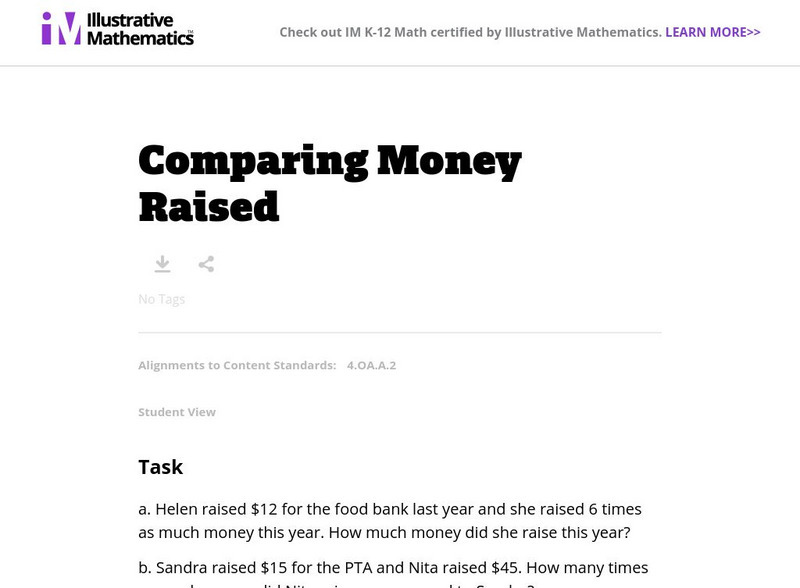Smithsonian Institution
Smithsonian Learning Lab: What Shape Is Money? Money Doesn't Have to Be Round or Rectangular
Pigs, rice, nuts, teeth, eggs, feathers - these are all types of currency! This lesson discusses different types of objects that can be used as currency and students will decide what qualities make an effective currency. Included are...
Khan Academy
Khan Academy: Lesson Summary: Definition, Measurement, and Functions of Money
This information is intended for AP Macroeconomics students or for those taking college macroeconomics. This lesson reviews key terms and calculations related to the definition, measurement, and functions of money. Topics include the...
Council for Economic Education
Econ Ed Link: Do I Look Like I'm Made of Money?
One of the most common replies given by parents when their children ask for money is "Do I look like I'm made of Money?" This lesson is designed to educate learners about the need for money as a generally accepted medium of exchange. The...
Better Lesson
Better Lesson: Time and Money
As the result of a Unit assessment, it was found that students showed some confusion with writing time and with adding sets of coins. These skills need to be reviewed to aid in mastery of the Common Core standards for time and money.
Better Lesson
Better Lesson: More Dimes and Dollars
Second graders need practice using coins and dollars and relating them to ones, tens and hundreds. Common Core standards include counting by 10s and 100s.
Scholastic
Scholastic: Adventures in Math: Lesson 3: Money in Our Community
Lesson focuses on how and why money circulated within our community. Being able to discern the difference between things we need and things we want is one of the foundational concepts for using money wisely. Goods and services are things...
Council for Economic Education
Econ Ed Link: Money Comes and Goes
Students read two online stories that introduce them to the elements of a budget and show that a successful budget balances money coming in (income) with money going out (expenses and savings). Follow-up activities point out the value of...
Better Lesson
Better Lesson: Identifying Coins
Find a lesson plan here to help students learn more about money that is all around them! Give them the chance to review coin identification with the coin game and practice.
Better Lesson
Better Lesson: Hundreds, Tens, Ones Are Coins Too
Second graders will extend their understanding of hundreds, tens and ones using dollars, dimes and pennies as another way to express groups of 100, 10 and 1.
University of Missouri
University of Missouri: Wise Pockets: Four Dollars and Fifty Cents
This is a lesson plan geared towards elementary level students. Using the book Four Dollars and Fifty Cents by Eric Kimmel, the teacher instructs students about the terms creditor, debtor, collateral, credit, and credit report. Lesson...
Illustrative Mathematics
Illustrative Mathematics: Saving Money 2
The purpose of this task is for students to relate addition and subtraction problems to money and to situations and goals related to saving money. A problem is given that will contain multiple solutions, this allows students to think...
University of Regina (Canada)
University of Regina: Math Central: Time, Money, and Temperature Lesson Plans
Money, time, and temperature are developed through several lessons. These topics of measurement are explained with suggested lessons, evaluations, instructional methods, and resources.
Yale University
Yale New Haven Teachers Institute: Income Budgeting
This site contains a unit on budgeting money for use by middle school teachers. Includes enrichment problems, a bibliography, and many example problems and situations.
CPALMS
Cpalms: Dollars for Density
This is a guided inquiry activity in which students use simple lab procedures and discussions to develop and apply the concept of density. Students collect and graph data which they use to explore the relationship between mass and...
University of Texas
Inside Mathematics: Pocket Money [Pdf]
This task challenges a student to demonstrate fluency in adding and subtracting whole numbers.
Scholastic
Scholastic: Adventures in Math: Lesson 1: Money Matters
The process of earning money is the cornerstone of financial literacy. For this lesson, young scholars will identify key terms associated with earning money, explore ideas for earning money now, and evaluate various career options as...
Council for Economic Education
Econ Ed Link: Where Does the Money Come From?
With very few exceptions, the U.S. federal government does not have an "income" to spend providing goods and services. The money used for federal spending programs must be collected as federal taxes, or it must be borrowed. This lesson...
Council for Economic Education
Econ Ed Link: What Face Do You Use?
The young scholars will recognize that in order to facilitate the exchange of goods and services, most nations create currency for use as money. They will examine the characteristics of money by comparing and contrasting examples of U.S....
Writing Fix
Writing Fix: Smart Math and Writing
In this lesson, the poem "Smart" from Where the Sidewalk Ends, by Shel Silverstein, is used as the mentor text. Students will write a map of the poem and then analyze it to discover what happened when trades with money were made and...
Council for Economic Education
Econ Ed Link: Changes in Change
This lesson plan begins with students visiting one web resource that gives them practice in counting money. The second resource goes one step further in that students are given opportunities to make change for make-believe purchases.
Council for Economic Education
Econ Ed Link: Show Me the Money!
Students will investigate unforeseen costs of car loans and/or house loans. They will then evaluate the economics of decision making, the ramifications of their choices, and options available to them. Students will compute costs and...
Illustrative Mathematics
Illustrative Mathematics: 4.oa Comparing Money Raised
The purpose of this task is for students to solve three comparisons problems that are related by their context but are structurally different. Multiplicative comparison is purposefully excluded from third grade (see 3.OA.3 and 3.MD.2),...
Other
Money Management International: The Berenstain Bears' Trouble With Money
A lesson plan featuring the Berenstain Bears that introduces the concepts of spending, goods, services, income, saving, and interest.
University of Regina (Canada)
University of Regina: Math Central: Middle Years Word Problems: 1999
An archived collection of real-life word problems for middle school students, several of which involve money. Other problems focus on distance or time.
Other popular searches
- Money Lessons
- Counting Money
- Adding and Subtracting Money
- Adding Money
- Money Math
- Money and Currency
- Money Games
- Australian Money
- Money Lesson Plans
- Money Place Values
- Saving Money
- Counting Money Worksheets














